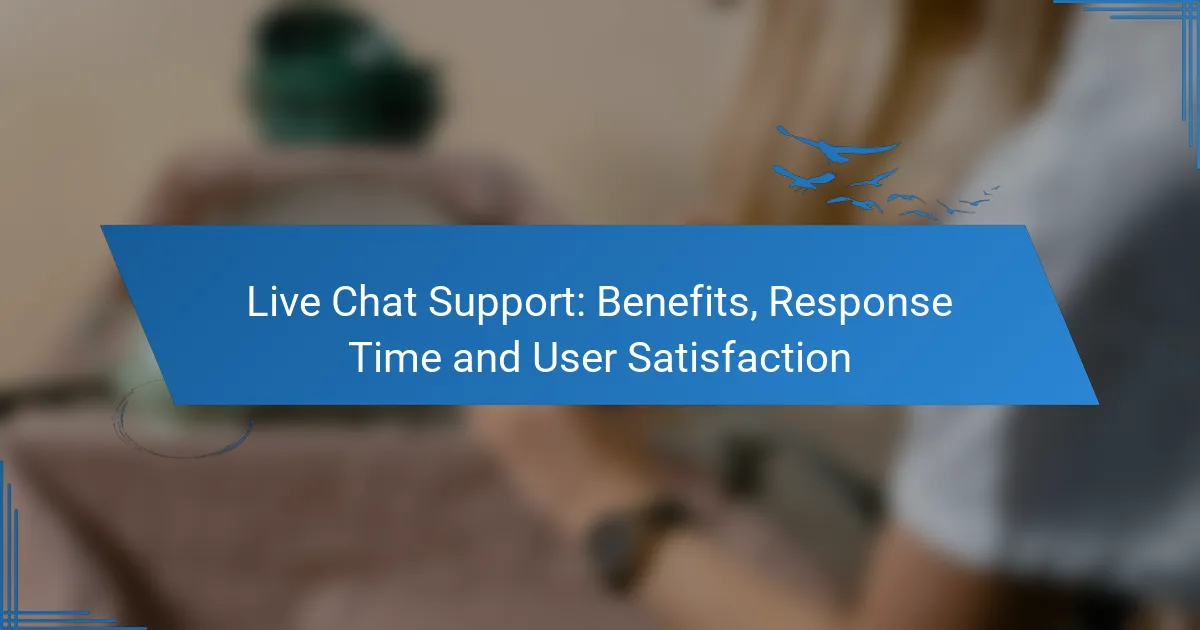Live chat support has become an essential tool for businesses, offering immediate assistance that enhances customer interactions and satisfaction. By enabling real-time communication, it allows companies to address inquiries quickly and efficiently, leading to improved response times and a more personalized experience for users.

What are the benefits of live chat support in the UK?
Live chat support in the UK offers immediate assistance and enhances customer interactions, leading to improved satisfaction. It allows businesses to engage with customers in real-time, addressing their needs efficiently and effectively.
Increased customer engagement
Live chat support significantly boosts customer engagement by providing instant communication. Customers appreciate the ability to ask questions and receive answers without delay, which fosters a more interactive experience.
Engagement can be further enhanced through proactive chat invitations, where representatives initiate conversations based on user behavior on the website. This approach can create a welcoming atmosphere that encourages customers to interact more freely.
Higher conversion rates
Implementing live chat can lead to higher conversion rates as it helps address potential customer concerns immediately. When customers receive prompt responses, they are more likely to complete their purchases rather than abandon their carts.
Many businesses report conversion increases in the range of 10-30% after introducing live chat, as the support can guide customers through the buying process and provide reassurance, ultimately leading to more sales.
24/7 availability
Live chat support can be available around the clock, ensuring that customer inquiries are addressed at any time. This constant availability is particularly beneficial for businesses with a global customer base or those operating outside standard business hours.
Utilizing chatbots for after-hours support can help manage inquiries when human agents are unavailable, providing basic assistance and capturing leads even during off-peak times.
Cost-effective customer service
Live chat support is often more cost-effective than traditional customer service channels like phone support. It allows agents to handle multiple chats simultaneously, reducing the need for a large customer service team.
Businesses can save on operational costs while maintaining high service levels, making it an attractive option for companies looking to optimize their customer support budget.
Real-time problem resolution
One of the primary advantages of live chat support is the ability to resolve issues in real-time. Customers can describe their problems, and agents can provide immediate solutions, minimizing frustration and downtime.
This quick resolution capability not only enhances customer satisfaction but also builds trust, as customers feel valued when their concerns are addressed promptly and effectively.

How does live chat support impact response time?
Live chat support significantly enhances response time by providing immediate assistance to users. This real-time interaction allows businesses to address customer inquiries quickly, leading to higher satisfaction rates.
Immediate responses to inquiries
Live chat enables businesses to respond to customer inquiries instantly, often within seconds. This immediacy reduces frustration and keeps users engaged, as they do not have to wait for email replies or phone call connections. For example, a customer can receive answers to simple questions like product availability or order status almost immediately.
Reduction in average handling time
With live chat, the average handling time for customer issues tends to decrease. Agents can manage multiple chats simultaneously, allowing them to resolve issues faster than traditional methods. This efficiency often leads to quicker resolutions, which can improve overall customer experience.
Comparison with email and phone support
Compared to email support, live chat offers a much faster response time, as emails can take hours or even days to receive a reply. Phone support, while immediate, often involves hold times and can be less efficient due to the one-on-one nature of calls. Live chat strikes a balance by providing quick responses while allowing agents to assist multiple customers at once.

What is the relationship between live chat support and user satisfaction?
Live chat support significantly enhances user satisfaction by providing immediate assistance and personalized interactions. Customers appreciate quick responses and the convenience of resolving issues without lengthy wait times.
Higher customer satisfaction scores
Implementing live chat support often leads to higher customer satisfaction scores, as users feel valued and heard. Many businesses report satisfaction ratings increasing by a notable percentage after introducing this feature, as it allows for real-time problem-solving.
To maximize satisfaction, ensure that chat agents are well-trained and equipped with the necessary tools to address inquiries efficiently. A responsive and knowledgeable support team can turn a potentially negative experience into a positive one.
Improved Net Promoter Score (NPS)
Live chat support can contribute to an improved Net Promoter Score (NPS), which measures customer loyalty and likelihood to recommend a business. Customers who receive prompt and effective assistance are more likely to promote the brand to others.
To enhance NPS, focus on reducing response times and ensuring that chat interactions are engaging and informative. Regularly soliciting feedback after chat sessions can also provide insights into areas for improvement.
Positive customer feedback examples
Many companies receive positive feedback highlighting the benefits of live chat support. Customers often express appreciation for the instant help they receive, which can lead to increased trust and loyalty.
For instance, a retail company might share testimonials from users who resolved their issues within minutes, contrasting sharply with longer wait times for phone support. Collecting and showcasing such feedback can further reinforce the value of live chat services.

What criteria should businesses consider when choosing live chat software?
Businesses should evaluate live chat software based on integration capabilities, user-friendliness, and pricing models. These factors influence how well the software fits into existing workflows, its ease of use for both agents and customers, and the overall cost-effectiveness of the solution.
Integration capabilities
Integration capabilities refer to how well the live chat software connects with other tools and platforms used by the business, such as CRM systems, email marketing software, and e-commerce platforms. A seamless integration can enhance workflow efficiency and provide a unified view of customer interactions.
When assessing integration options, look for software that supports popular platforms and offers APIs for custom solutions. For instance, a live chat tool that integrates with Salesforce can streamline customer data management and improve response times.
User-friendly interface
A user-friendly interface is crucial for both customer support agents and users. The software should be intuitive, allowing agents to navigate easily and respond quickly to inquiries. A cluttered or complex interface can lead to frustration and longer response times.
Consider testing the software with real users to gauge its usability. Features like customizable chat widgets, easy access to customer information, and quick response templates can significantly enhance the user experience.
Pricing models for subscription services
Pricing models for live chat software can vary widely, typically falling into monthly or annual subscription plans. Some providers offer tiered pricing based on features, number of users, or chat volume, while others may have a flat rate.
Evaluate the total cost of ownership, including any additional fees for integrations or premium features. Look for options that provide a free trial or a money-back guarantee to assess the software’s effectiveness before committing financially. Aim for a solution that balances cost with the necessary features to meet your business needs.

How can businesses measure the effectiveness of live chat support?
Businesses can measure the effectiveness of live chat support through various metrics that reflect customer interactions and satisfaction. Key performance indicators, customer satisfaction surveys, and response time analytics are essential tools for assessing how well live chat meets customer needs.
Key performance indicators (KPIs)
Key performance indicators (KPIs) provide quantifiable measures of live chat support effectiveness. Common KPIs include chat volume, resolution rate, and average handling time. Tracking these metrics helps businesses understand operational efficiency and identify areas for improvement.
For example, a high resolution rate indicates that agents are effectively solving customer issues during the chat. Aim for a resolution rate of over 80% to ensure that most customer inquiries are addressed successfully.
Customer satisfaction surveys
Customer satisfaction surveys are a direct way to gauge user sentiment regarding live chat support. After a chat session, businesses can prompt customers to rate their experience, typically on a scale from 1 to 5. This feedback provides insights into customer perceptions and highlights areas needing attention.
Consider implementing short surveys that ask specific questions about the chat experience, such as the agent’s helpfulness and the clarity of information provided. An average satisfaction score above 4 is generally considered favorable.
Response time analytics
Response time analytics measure how quickly agents respond to customer inquiries in live chat. Fast response times are crucial for maintaining customer satisfaction, with ideal initial response times often falling within the range of 10 to 30 seconds. Delays can lead to frustration and increased abandonment rates.
Regularly analyze response times to identify trends and peak periods. If response times exceed 30 seconds during busy hours, consider adjusting staffing levels or implementing automated responses to manage customer expectations effectively.

What are the emerging trends in live chat support?
Emerging trends in live chat support include the integration of artificial intelligence, personalized customer experiences, and the use of omnichannel strategies. These developments enhance efficiency, improve response times, and increase user satisfaction.
AI and Automation
AI and automation are transforming live chat support by enabling chatbots to handle routine inquiries. This allows human agents to focus on more complex issues, improving overall efficiency. Many businesses are adopting AI-driven tools that can provide instant responses, reducing wait times significantly.
Personalization
Personalization in live chat support involves tailoring interactions based on customer data and previous interactions. This can lead to higher user satisfaction as customers feel valued and understood. For instance, using a customer’s name and recalling past purchases can create a more engaging experience.
Omnichannel Support
Omnichannel support ensures that customers can switch between different communication channels seamlessly. This trend allows users to start a conversation on one platform and continue it on another without losing context. Businesses are increasingly integrating live chat with social media, email, and phone support to provide a cohesive experience.
